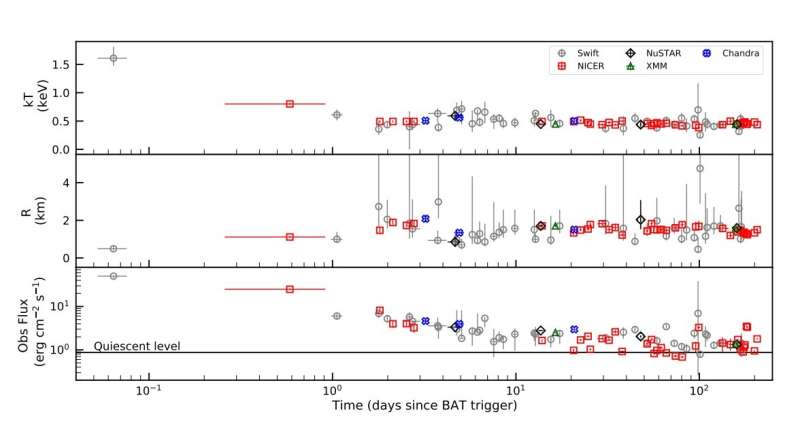May 18, 2022 report
Outbursts of magnetar SGR J1935+2154 investigated in detail

European astronomers have conducted a detailed, long-term X-ray monitoring campaign of a magnetar known as SGR J1935+2154, since it entered its active phase, experiencing numerous X-ray outbursts. Results of the study, published May 10 on arXiv.org, could help us better understand the nature of this magnetar.
Magnetars are neutron stars with extremely strong magnetic fields, more than 1 quadrillion times stronger than the magnetic field of our planet. Decay of magnetic fields in magnetars powers the emission of high-energy electromagnetic radiation, for instance, in the form of X-rays or radio waves.
Detected in 2014, SGR J1935+2154 (or SGR J1935 for short) is a magnetar with a spin period of 3.25 seconds and a surface dipolar magnetic field at a level of about 220 trillion G at the pole. It has been one of the most active magnetars since its discovery, experiencing outbursts in February 2015, May and June 2016, and also frequent bursting episodes.
The latest reactivation of SGR J1935 commenced on April 27, 2020, when it started to exhibit hundreds of X-ray bursts and a large enhancement of the persistent flux was detected. Then, a team of astronomers led by Alice Borghese of the Institute of Space Sciences (ICE-CSIC) in Barcelona, Spain, began to monitor this magnetar NASA's Chandra, Swift and NuSTAR spacecraft, ESA's XMM–Newton satellite, and NICER instrument on the International Space Station (ISS).
"In this paper, we report on the X-ray spectral and timing properties of SGR J1935+2154 based on a long-term monitoring campaign with Chandra, XMM–Newton, NuSTAR, Swift and NICER covering a time span of about 7 months since the outburst onset," the researchers wrote.
When SGR J1935 entered its fifth recorded outburst phase, it made it one of only a few magnetars showing recurrent outbursts and frequent bursting activity. This phase included a remarkable X-ray burst forest (with more than 200 bursts detected in about 20 minutes), and emission of an intense radio burst with properties resembling those of fast radio bursts (FRBs) and a X-ray counterpart.
The results show that the broadband spectrum of SGR J1935 exhibited a non-thermal power-law component extending up to about 20–25 keV throughout the observational campaign and a blackbody component with temperature decreasing from approximately 1.5 keV at the outburst peak to around 0.45 keV in the following months. The corresponding emitting area was rather steady in time, with a radius of some 1.6 kilometers.
The study also found that SGR J1935 reached quiescence level around 80 days after the outburst onset, releasing an energy of approximately 60 duodecillion erg during the outburst. It was noted that the observations have not detected either pulsed emission or radio bursts, which, according to the authors of the paper, seems to suggest that SGR J1935 can swing between radio-loud and radio-quiet states.
More information: Alice Borghese et al, The first 7 months of the 2020 X-ray outburst of the magnetar SGR J1935+2154. arXiv:2205.04983v1 [astro-ph.HE], arxiv.org/abs/2205.04983
© 2022 Science X Network




















